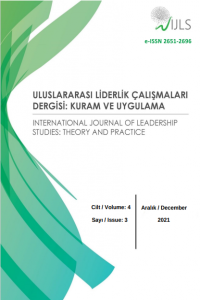Research Article
Review
Aim & Scope
"International Journal of Leadership Studies: Theory And Practice", which started publication in August 2018, aims to publish researches in the field of leadership and management and to present them to the service of scientists.
"International Journal of Leadership Studies: Theory And Practice" always adopts a publication policy based on international scientific and academic standards. In this context, "International Journal of Leadership Studies: Theory And Practice" publishes seminars, conferences and symposium reviews as well as original articles and book introductions, which will contribute to the field of leadership and management.
Author Guidelines
In order to be evaluated for the articles submitted to the journal, the article must be prepared in accordance with the journal’s writing rules. Manuscripts that are inappropriate in terms of these rules and formatting are not evaluated and returned to the author for rearrangement.
1. Edit your article according to the article template of our journal without changing the formatting.
2. All the content of the manuscript should be written in Times New Roman font with 11 font size and 1.15 cm line spacing.
3. In Turkish title; all letters should be capital, 12-point, and straight, bold and centered.
4. Abstract titles should be left justified and italic in 12-point. Abstract text should be written in Times New Roman font with 10-point and single line spacing.
5. Abstract should be arranged to include the aim, method and findings of the article and should not exceed 250 words.
6. Only the initials of each word in the English title should be capital letters, the rest should be lowercase (conjunctions should start with lowercase), and title should be written in 12 points, bold, italic and centered.
7. “Keywords” and “Keywords” headings should be italic and bold, followed by the words should be written in 10 point. Keywords should not be bold.
8. The main headings should be “centered” and the subheadings should be left-justified. Each paragraph should be indented “1.25” cm from the left and the interval between paragraphs should be “6 pt” before and after. In addition, the line spacing in the text should be written as “1.15” cm. In-text titles should be arranged according to APA 6 title levels.
APA Heading Levels
Title Level Title Articles
Level 1 Title Centered, Bold, First Letter of Words
Level 2 Title Left-justified, Bold, First Letter of Words
Level 3 Title Indented, Thick, The first word starts with a capital letter, there is no point.
Level 4 Title Indented, Bold, Italic, The first word starts with a capital letter, there is no point.
Level 5 Title Indented, Italic, The first word starts with a capital letter, there is no point.
9. Tables should include the number and title. “Times New Roman” 9 point, single line spacing should be used in the tables. Table headings should be left-aligned above the table. The name of the table should be written in italics. The table should not have sideline and column lines. Sample tables in the article template can be examined.
10. Figures should be prepared for black and white printing. Figure numbers and names should be written in 9 point. The title of the figure should be written in italics and only the first letter of the first word should be capitalized. In the naming of pictures, the rules in the figures and tables must be followed. Figures, tables and images should not exceed one third of the article in terms of the number of pages. Sample templates in the article template can be examined.
11. Emphasis should be made in italics.
12. When submitting an article to our journal, please know enough about APA citation style. Page numbers are abbreviated as follows: (Erçetin, 2016, p. 68). Do not use abbreviations as follows: (Erçetin, 2016: 68).
13. “Research and Publication Ethics, the Authors’ Proportion of the Contribution into the Articles, Declaration of Funding, Acknowledgment and Disclosure Statement” should be provided. “Declaration of Funding and Acknowledgment” are not compulsory but other headings are.
14. Bibliography section should start from the new page.
15. See the article template for sample bibliography presentations.
16. “Bibliography” title should be 12 points, bold and centered. The contents of the bibliography should be in accordance with APA 6 with “Times New Roman”, 11 point and 1 line spacing.
17. Each reference given in the text should be listed in the bibliography list in alphabetical order.
18. If there is no source in the bibliography, the title of the source is considered as the author's name and is listed alphabetically according to the first letter of the title.
19. The name of each work given in the bibliography should be indented 1.25 cm from the left in the second line.
Ethical Principles and Publication Policy
Code of Ethics
International Journal of Leadership Studies: Theory and Practice is a peer-reviewed journal published in accordance with the following ethical principles and rules in order to publish original articles and book introductions that will contribute to the field of management and leadership, as well as to present seminars, conferences and symposium evaluations. Articles submitted to International Journal of Leadership Studies: Theory and Practice are evaluated through blind peer review process and published electronically with free access. Below are the ethical responsibilities, roles and duties of authors, journal editors, reviewers and publishers. The following ethical principles and rules are determined by the Committe on Publication Ethics - (COPE). In addition, in International Journal of Leadership Studies: Theory and Practice, information about cases considered as plagiarism and unethical behaviors is given.
Author(s)
The work submitted to the International Journal of Leadership Studies: Theory and Practice should be related to the field of leadership and management.
The sources used in the study should be given in full and arranged according to APA6 format.
Articles submitted to the journal should not have been sent to another journal and 'Copyright Transfer Form' should be filled out.
Persons who did not contribute to the study should not be cited as authors.
Authors should inform the editor and editorial board if they find a mistake in their work, and collaborate for the correction or withdrawal process
It is mandatory to obtain the Ethics Committee Permit Certificate for the process starting in 2020 and the research data for the articles of 2020.
Reviewers
All articles submitted to International Journal of Leadership Studies: Theory and Practice are evaluated through blind peer review process. Blind peer review means that the authors are kept secret from the reviewers and the reviewers are kept secret from the authors in order to ensure a neutral, objective and independent evaluation process. The articles are sent to the reviewers through the journal management system for evaluation. This system is performed through DergiPark . The reviewers are required to fill out a form with decisions on whether they will contribute to the field of management or leadership and the reasons for such decisions. Ethical responsibilities and roles of reviewers of International Leadership Studies: Theory and Practice are as follows:
Reviewers are required to review only in the field of their expertise.
The reviewers should evaluate the work neutrally and objectively.
The reviewers are required to fill out the IJLS Judge Evaluation Form for the articles they are evaluating and are not expected to give their name on the forms in order to avoid damaging the blind pier review process. The reviewers are also required to state in this form whether the article they are evaluating can be published or not, and the reasons for their decision.
Reviewers should use academic language in their suggestions and make their comments in a polite manner. If it is determined that the reviewers use non-academic language, they may be asked by the editorial board to review and correct their comments.
The reviewers are required to complete their assessment within the time given to them and are expected to comply with the ethical responsibilities stated.
Editor
The editor shall comply with the ethical responsibilities which are on COPE Code of Conduct and Best Practice Guidelines for Journal Editors and COPE Best Practice Guidelines for Journal Editors which were published by Committe on Publication Ethics - COPE and below listed. The editor is responsible for all articles published in the journal. The editor's ethical duties and responsibilities are as follows:
General Responsibilities
The editor is obliged to make an effort to increase the quality of the journal and contribute to its development.
The editor should support the authors' freedom of expression.
Relations with Readers
The editor should make efforts to ensure that the published articles are compatible with the knowledge and skills of the journal readers.
Relations with Reviewers
The editor should ask the reviewers to evaluate the articles according to their knowledge and expertise.
The editor should provide all the necessary information to the reviewers about the reviewer evaluation process. The editor should ensure that the review process is carried out as a blind peer review process.
The editor should constantly update and expand the list of reviewers according to the expertise of the reviewers.
Relations with Authors
The editor should constantly update the journal's editorial rules and sample template.
The editor should evaluate the articles submitted to the journal in terms of journal writing rules, the importance and originality of the study, and if he/she decides to reject the article during the first submission process, he/she should communicate the reason for this to the author in a clear and unbiased manner. In this process, if it is decided that the article should be reviewed in terms of grammar, punctuation and/or spelling rules (margins, proper reference, etc.), authors should be informed and given time to make the necessary corrections.
Articles should include submission and acceptance of publication dates.
When the authors request information about the status of their article, the authors should be informed about the status of their article so as not to disrupt the blind peer review process.
Publisher
The publisher of International Journal of Leadership Studies: Theory and Practice is Dr. Şefika Şule ERÇETİN. The ethical responsibilities of the publisher are as follows:
The Publisher acknowledges that the decision-making body and the review process are the responsibility of the editorial board during the publication of the articles in the Journal of
International Leadership Studies: Theory and Practice.
The publisher provides open, electronic and free access to the journal: https://dergipark.org.tr/tr/pub/ijls
Plagiarism and Unethical Behavior
All studies submitted to International Journal of Leadership Studies: Theory and Practice are scanned with iThenticate software program before they are published. The highest accepted similarity rate is 15%. Articles exceeding this ratio are reviewed in detail and if deemed necessary, sent back to the authors for review or correction; if plagiarism or unethical behavior is detected publication may be rejected.
Some unethical behaviors are as follows:
Citing the persons who do not contributed to the study as authors.
Not citing the persons who contributed to the study as authors.
Not mentioning the article is produced from the author's master's/doctoral thesis or a project.
Slicing, meaning, publishing more than one article from a single study.
Exposing the blind peer review process.
Indexes
Journal Boards
Editors-in-chief

Editors


Technical Arrangement









